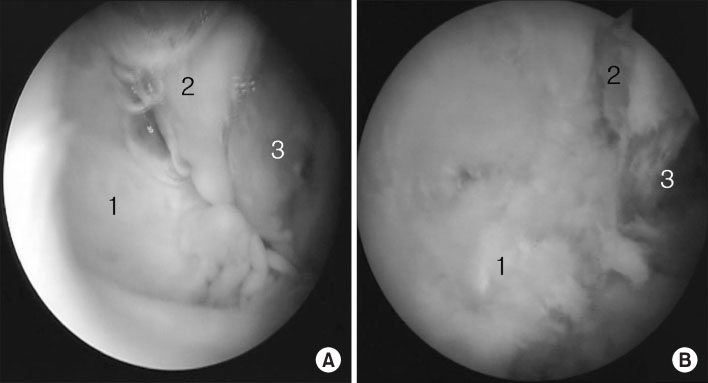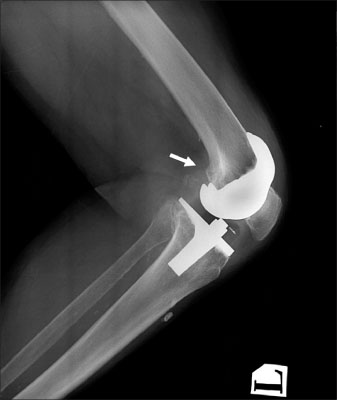J Korean Orthop Assoc.
2007 Dec;42(6):832-835. 10.4055/jkoa.2007.42.6.832.
Arthroscopic Treatment of Fabella Impingement Syndrome after Total Knee Arthroplasty: A Case Report
- Affiliations
-
- 1Masan Medical Center, Jinju, Korea.
- 2Department of Orthopaedic Surgery, College of Medicine, Gyeongsang National University, Jinju, Korea. hychan@gaechuk.gsnu.ac.kr
- 3Gyeong-Sang Institute of Health Science, Jinju, Korea.
- KMID: 1947793
- DOI: http://doi.org/10.4055/jkoa.2007.42.6.832
Abstract
- Fabella impingement syndrome after total knee arthroplasty (TKA) is a rare condition. However, the location of the inserted prosthesis and the size of the fabella are considered major causative factors. Thus far, a conventional surgical excision of the impinged fabella is recommended treatment for the impingement. A 72-year-old woman was diagnosed with degenerative arthritis of the knee. She complained of fabella impingement due to an incompletely excised bony spur behind the posterolateral femoral prosthesis after TKA. The fabella and remaining bony spur were removed using an arthroscopic procedure. The impingement has not recurred and the range of motion (ROM) of the knee was improved after a 12 months follow-up. Arthroscopic surgery might be an alternative treatment for fabella impingement after TKA.
MeSH Terms
Figure
Reference
-
1. Bae DK, Cho CH. Fabella impingement syndrome: 1 case. Korean Knee Soc. 1998. 10:130–134.2. Jaffe FF, Kuschner S, Klein M. Fabella impingement: a cause of pain after total knee replacement. A case report. J Bone Joint Surg Am. 1988. 70:613–616.3. Johnson DR, Friedman RJ, McGinty JB, Mason JL, St Mary EW. The role of arthroscopy in the problem total knee replacement. Arthroscopy. 1990. 6:30–32.
Article4. Klinger HM, Baums MH, Spahn G, Ernstberger T. A study of effectiveness of knee arthroscopy after knee arthroplasty. Arthroscopy. 2006. 21:731–738.
Article5. Larson JE, Becker DA. Fabellar impingement in total knee arthroplasty. A case report. J Arthroplasty. 1993. 8:95–97.6. Mangieri JV. Peroneal-nerve injury from an enlarged fabella. A case report. J Bone Joint Surg Am. 1973. 55:395–397.7. Takahashi M, Miyamoto S, Nagano A. Arthroscopic treatment of soft-tissue impingement under the patella after total knee arthroplasty. Arthroscopy. 2002. 18:E20.
Article8. Weiner D, Macnab I, Turner M. The fabella syndrome. Clin Orthop Relat Res. 1977. 126:213–215.
Article
- Full Text Links
- Actions
-
Cited
- CITED
-
- Close
- Share
- Similar articles
-
- Fabella Impingement Syndrome: 1 Case
- Synovial Impingement after Total Knee Replacement Arthroplasty: A Case Report
- Successful Treatment of Anterior Knee Impingement Syndrome in Taekwondo Athletes
- Effect of Radial Extracorporeal Shock Wave Therapy in Patients With Fabella Syndrome
- Lateral fat pad Impingement Syndrome: A Case Report




